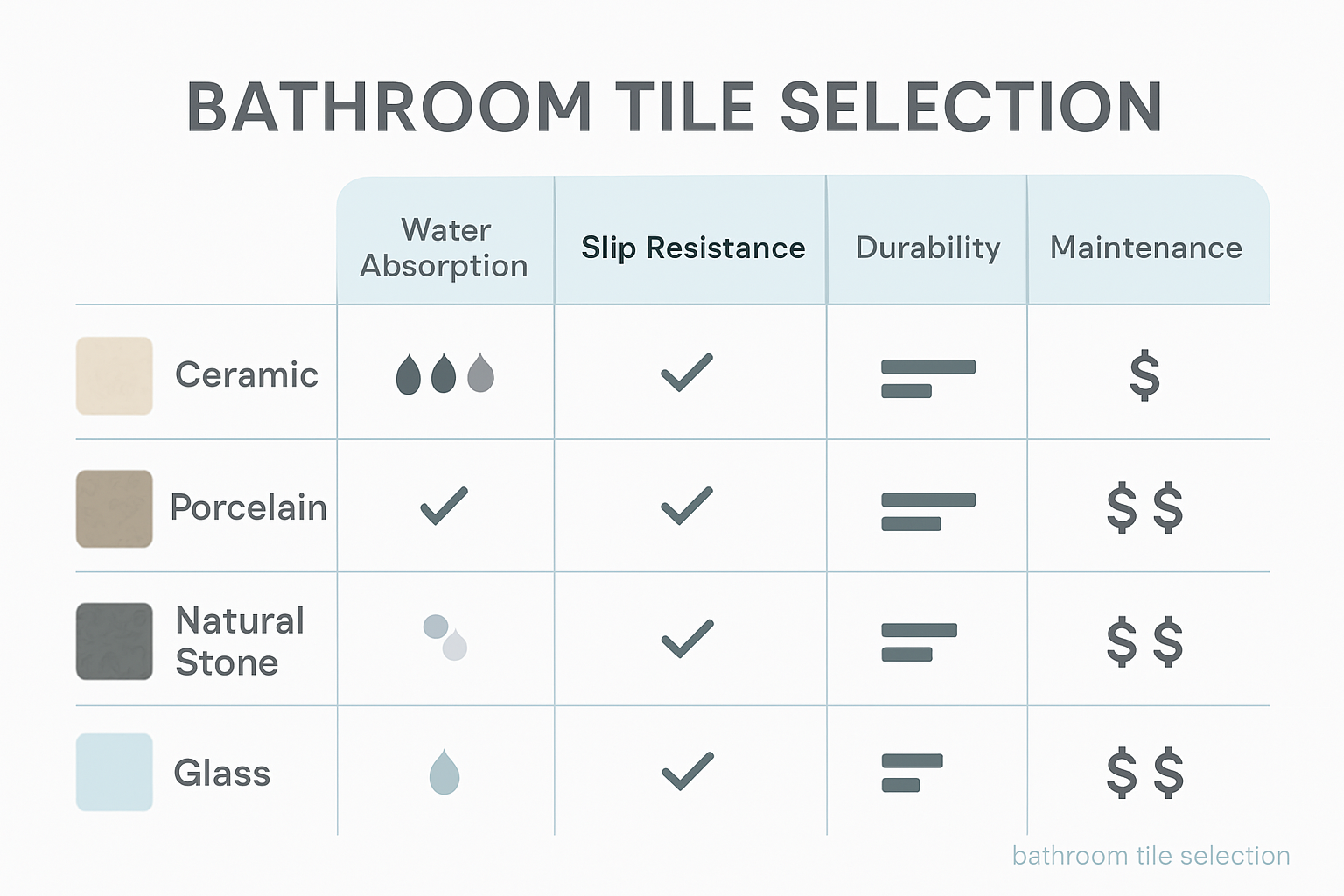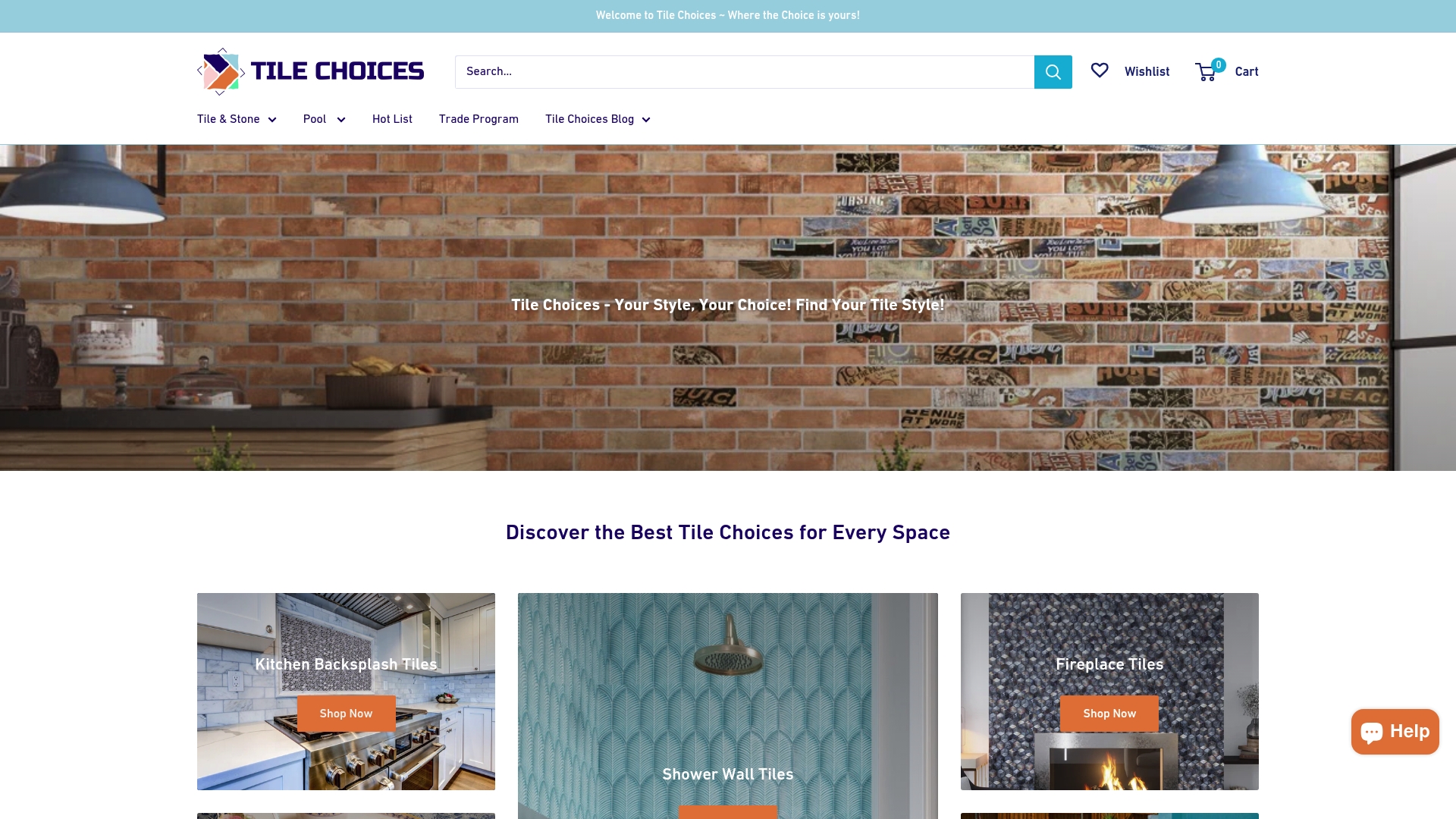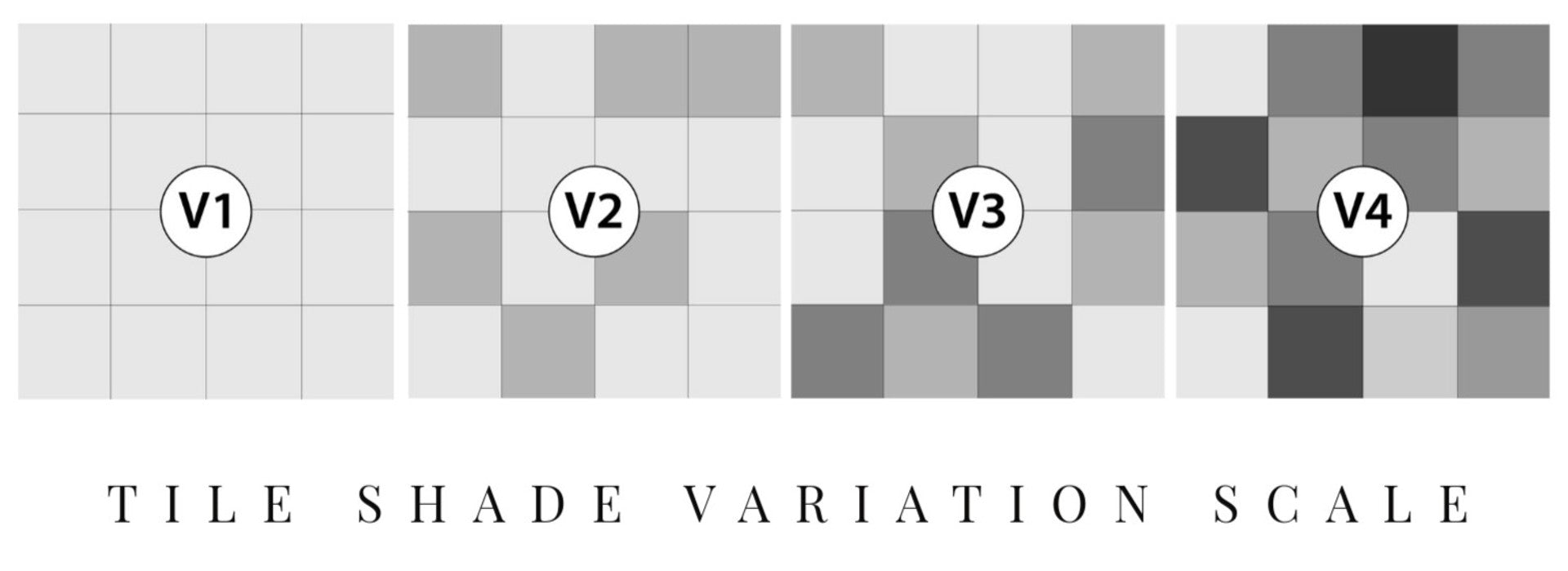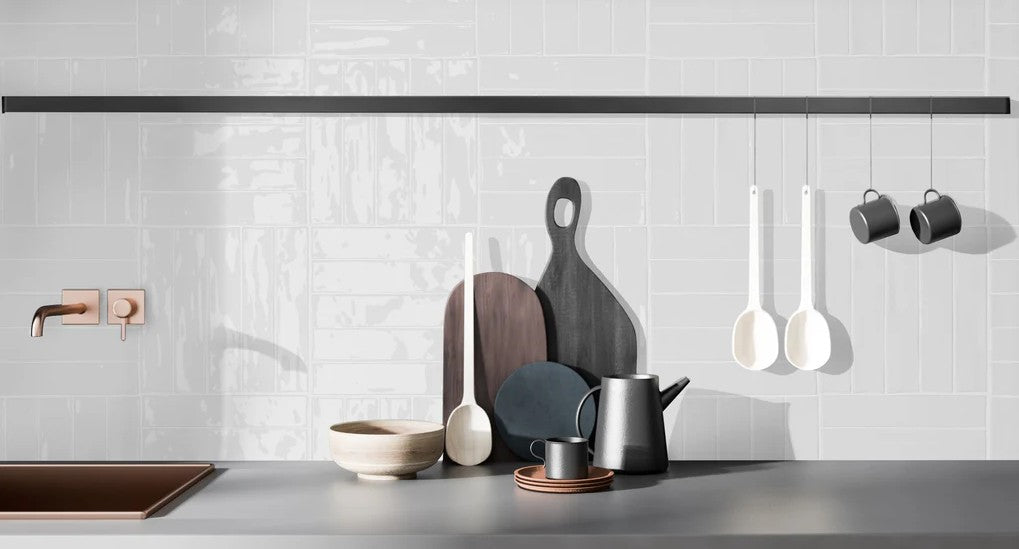Choosing bathroom tiles sounds easy until you see the endless styles, materials, and finishes staring back at you. Imagine this. Porcelain tiles can have water absorption rates as low as 0.5 percent yet the wrong pick can lead to slippery floors or high-maintenance nightmares. Most people get dazzled by looks and totally miss the specs that actually matter for a safe, low-hassle bathroom.
Table of Contents
- Understanding Bathroom Tile Materials And Types
- How To Choose The Right Tile For Your Space
- Design And Style Tips For Stunning Results
- Common Bathroom Tile Selection Mistakes To Avoid
Quick Summary
| Takeaway | Explanation |
|---|---|
| Choose durable tiles for wet areas | In areas like showers and floors, select tiles like porcelain or ceramic with minimal water absorption to enhance performance. |
| Assess traffic intensity for tile choice | The bathroom’s usage frequency affects tile durability; high-traffic zones require tougher materials like dense ceramic or porcelain. |
| Balance budget with long-term maintenance | Consider ongoing maintenance costs and installation intricacies alongside initial tile prices for an informed budget. |
| Avoid mixing tile batches | Purchase all required tiles from a single batch to ensure consistent color and texture for a cohesive look. |
| Understand slip resistance ratings | Look for tiles with high Coefficient of Friction ratings to enhance safety in wet bathroom areas, reducing slip hazards. |
Understanding Bathroom Tile Materials and Types
Selecting the right bathroom tile involves more than just aesthetic appeal. Your tile choice impacts durability, maintenance, water resistance, and overall bathroom performance. Each material brings unique characteristics that can transform your space while meeting practical requirements.
Ceramic and Porcelain Tiles: The Bathroom Classics
Ceramic and porcelain tiles remain the most popular choices for bathroom installations. Ceramic tiles offer excellent versatility with a wide range of colors, patterns, and textures. They are manufactured from clay and fired at high temperatures, creating a durable surface that resists moisture and wear. Porcelain tiles take durability a step further. These dense, less porous tiles can withstand heavy foot traffic and moisture exposure, making them ideal for bathroom floors and shower walls.
Porcelain tiles come in two primary varieties: glazed and unglazed. Glazed porcelain features a protective glass layer that enhances stain resistance and allows for more intricate design possibilities. Unglazed porcelain provides a more natural, textured appearance and offers superior slip resistance. Professional designers often recommend porcelain for bathrooms requiring maximum durability and minimal maintenance.
Natural Stone Tiles: Bringing Organic Beauty Indoors
Natural stone tiles introduce an element of luxury and organic beauty to bathroom spaces. Materials like marble, granite, slate, and travertine each offer unique visual characteristics and performance attributes. Marble tiles provide elegant, smooth surfaces with distinctive veining patterns. They work exceptionally well for creating sophisticated bathroom environments but require more maintenance compared to ceramic or porcelain.
Slate tiles bring rugged texture and natural color variations, perfect for creating rustic or contemporary design schemes. Granite offers exceptional hardness and resistance to scratching, making it suitable for high-traffic bathroom areas. However, natural stone tiles typically need regular sealing to protect against moisture absorption and staining.
Specialty and Innovative Tile Options
Beyond traditional materials, innovative tile options continue expanding design possibilities. Glass tiles provide luminous, reflective surfaces that can make smaller bathrooms feel more spacious. Metal tiles offer industrial and modern aesthetics, while mosaic tiles allow intricate pattern creation. Some homeowners are exploring unique tile design solutions that combine multiple materials and textures to create personalized bathroom environments.
When selecting bathroom tiles, consider factors beyond appearance. Evaluate water absorption rates, slip resistance, maintenance requirements, and compatibility with your specific bathroom layout. Professional tile selection demands balancing aesthetic preferences with practical performance needs. By understanding each material’s strengths and limitations, you can create a bathroom that looks stunning and functions flawlessly for years to come.
Here’s a comparison table highlighting the features, benefits, and key considerations of popular bathroom tile materials, as described in the article.
| Tile Material | Main Features | Benefits | Maintenance Considerations |
|---|---|---|---|
| Ceramic | Wide range of colors, patterns, and textures | Versatile, moisture and wear resistant | Low maintenance |
| Porcelain | Dense, less porous, comes glazed/unglazed | Superior durability, minimal water absorption, ideal for wet/high-traffic areas | Easy to maintain, minimal sealing needed |
| Marble (Natural Stone) | Elegant, smooth surface, veining | Luxurious appearance | Requires regular sealing, higher maintenance |
| Slate (Natural Stone) | Rugged texture, natural variation | Adds texture and rustic/modern appeal | Needs sealing, more cleaning |
| Granite (Natural Stone) | Very hard, scratch resistant | Suitable for high-traffic areas | Periodic sealing required |
| Glass | Luminous, reflective surfaces | Makes spaces feel bigger, modern look | Easy cleaning, grout maintenance important |
| Metal | Industrial, modern look | Unique style, accent use | Can be prone to scratches or tarnishing |
| Mosaic | Allows intricate designs | Artistic, customizable | Grout lines need more cleaning |

How to Choose the Right Tile for Your Space
Selecting the perfect bathroom tile requires strategic thinking beyond aesthetic preferences. Your tile choice impacts functionality, maintenance, longevity, and overall bathroom performance. Understanding key selection criteria helps you make an informed decision that balances visual appeal with practical requirements.
Assessing Bathroom Location and Usage Intensity
The specific area within your bathroom significantly influences tile selection. High moisture zones like shower walls and bathroom floors demand different tile characteristics compared to less exposed areas. Shower walls require tiles with minimal water absorption and strong adhesive properties. Bathroom floors need tiles with superior slip resistance and durability to withstand constant foot traffic and potential water exposure.
Traffic intensity plays a crucial role in tile selection. A main family bathroom experiences more wear compared to a guest powder room. High-traffic areas require harder, more resilient tiles like porcelain or dense ceramic. Some homeowners opt for designer tile collections that combine aesthetic versatility with robust performance characteristics.
Understanding Tile Performance Specifications
Professional tile selection involves examining technical specifications that determine long-term performance. Water absorption rate represents a critical metric for bathroom tiles. Tiles with lower absorption rates resist moisture penetration more effectively, reducing potential damage from humidity and water exposure. Porcelain tiles typically offer the lowest absorption rates, making them ideal for moisture-rich environments.
Another crucial specification is the Coefficient of Friction (COF), which measures slip resistance. For bathroom floors, especially in areas prone to water splashes, selecting tiles with higher COF ratings becomes essential for safety. Textured tiles or those with slightly rough surfaces provide better traction compared to completely smooth tiles.
Budget and Maintenance Considerations
Budget plays a significant role in tile selection, but it should not be the sole determining factor. While initial tile costs matter, long-term maintenance expenses are equally important. Natural stone tiles might have a higher upfront cost and require periodic sealing, whereas ceramic and porcelain tiles offer more affordable and low-maintenance alternatives.
Consider installation complexity and potential additional expenses. Some intricate tile designs require specialized installation techniques, increasing overall project costs. Professional installation ensures proper placement, waterproofing, and longevity. Factor in grout selection, as different tile materials and layouts demand specific grout types that impact both appearance and maintenance requirements.
Successful bathroom tile selection demands a holistic approach. Evaluate your specific needs, understand performance specifications, and balance aesthetic preferences with practical requirements. By carefully considering location, usage intensity, technical specifications, budget, and maintenance needs, you can select tiles that transform your bathroom into a beautiful, functional space that withstands daily challenges and maintains its appeal for years to come.
Design and Style Tips for Stunning Results
Transforming your bathroom with tiles goes beyond simple material selection. Design and style play crucial roles in creating a space that feels both functional and visually compelling. Strategic tile choices can dramatically enhance your bathroom’s aesthetic appeal while reflecting your personal design sensibilities.
Color and Pattern Strategies
Color selection represents the foundational element of bathroom tile design. Lighter tiles create an illusion of spaciousness, making smaller bathrooms feel more open and airy. Soft neutral tones like warm whites, light grays, and subtle beiges provide timeless elegance and versatility. These colors serve as excellent backdrops for more dynamic design elements and allow greater flexibility in accessorizing.
Pattern selection offers another powerful design tool. Large format tiles minimize grout lines, creating a seamless and modern appearance. Geometric patterns like hexagon or chevron tiles introduce visual complexity and contemporary flair. Some homeowners prefer intricate mosaic designs that transform walls into artistic statements. Contemporary tile collections now offer unprecedented design flexibility, allowing creative combinations of colors, shapes, and textures.
Layout and Placement Techniques
Tile layout dramatically influences a bathroom’s perceived dimensions and aesthetic flow. Traditional horizontal layouts create a classic look, while diagonal or herringbone patterns add dynamic movement and visual interest. Vertical tile installations can make ceiling heights appear more expansive, an excellent technique for bathrooms with limited vertical space.
Consider creating visual focal points through strategic tile placement. An accent wall in the shower or behind the vanity can introduce dramatic design elements without overwhelming the entire space. Mixing tile sizes and incorporating decorative border tiles provides sophisticated detailing that elevates the overall design. Mixing matte and glossy finishes within the same color palette creates subtle depth and sophistication.
Harmonizing Tile with Overall Bathroom Design
Successful bathroom tile design requires holistic consideration of surrounding elements. Tiles should complement fixtures, cabinetry, and overall color schemes. Metallic tile accents can coordinate with faucet and shower hardware, creating a cohesive visual narrative. Natural stone tiles work beautifully with wooden vanities, while sleek porcelain tiles pair well with modern minimalist designs.
Texture plays a critical role in tile selection. Smooth, large format tiles create a sense of calm and spaciousness. Textured tiles introduce tactile richness and can help prevent slipping in wet areas. Consider the bathroom’s lighting when selecting tile textures, as different surface finishes interact uniquely with natural and artificial light.
Designing with tiles is an art form that balances technical performance with aesthetic expression. By understanding color dynamics, exploring creative layouts, and harmonizing tile selections with broader design elements, you can create a bathroom that is both visually stunning and functionally superior. Remember that the most successful designs emerge from careful consideration of personal style, practical requirements, and design principles.
Common Bathroom Tile Selection Mistakes to Avoid
Selecting bathroom tiles involves more than just picking attractive designs. Many homeowners inadvertently make critical errors that compromise their bathroom’s functionality, durability, and overall aesthetic appeal. Understanding these common pitfalls can help you make more informed decisions and avoid costly mistakes.
This table organizes common bathroom tile selection mistakes into categories with descriptions and suggested solutions directly from the article’s content.
| Mistake Category | Description | Solution/Recommendation |
|---|---|---|
| Overlooking Performance Specifications | Focusing only on appearance, ignoring slip resistance, absorption, durability | Prioritize technical specs for each bathroom area |
| Ignoring Installation and Maintenance Complexities | Underestimating specialized installation or ongoing care for some tiles | Assess installation needs, choose suitable grout |
| Budget Misconceptions and Improper Planning | Not factoring in full project costs, getting tiles from inconsistent batches | Account for all expenses, buy from one tile batch |
Overlooking Performance Specifications
One of the most significant mistakes in bathroom tile selection is prioritizing appearance over technical performance. Homeowners often choose tiles based solely on visual appeal without considering crucial specifications like water absorption rates, slip resistance, and durability. Each bathroom area demands specific tile characteristics. Shower walls require tiles with minimal water absorption, while bathroom floors need high slip resistance and exceptional durability.
The Coefficient of Friction (COF) becomes critically important for floor tiles. Many people unknowingly select tiles that become dangerously slippery when wet. Professional designers recommend tiles with textured surfaces or those specifically rated for wet areas. Some innovative tile collections now offer advanced safety features that combine aesthetic appeal with superior performance characteristics.
Ignoring Installation and Maintenance Complexities
Most homeowners underestimate the complexity of tile installation and long-term maintenance. Choosing intricate tile designs or materials that require specialized installation can significantly increase project costs. Natural stone tiles, while beautiful, demand periodic sealing and more sophisticated maintenance compared to ceramic or porcelain alternatives. Some tile materials are more prone to staining, chipping, or water damage if not properly installed or maintained.
Grout selection represents another frequently overlooked aspect. Inappropriate grout choices can compromise tile performance and appearance. Porous grouts in high-moisture areas can lead to mold growth and water damage. Epoxy grouts offer better water resistance but come with higher installation costs and complexity. Homeowners should consider grout color, width, and material compatibility when selecting bathroom tiles.
Budget Misconceptions and Improper Planning
Budget-related mistakes can derail entire bathroom tile projects. Many people focus exclusively on tile costs without accounting for additional expenses like substrate preparation, professional installation, specialized tools, and potential structural modifications. Cheaper tiles might seem economical initially but can result in higher long-term maintenance and replacement costs.
Another common error involves inconsistent tile quality and shade variations. Purchasing tiles from multiple batches or different manufacturers can result in noticeable color and texture differences. Professional designers recommend purchasing all required tiles from a single batch and ordering approximately 10-15% extra to account for cuts, breakage, and future repairs.
Successful bathroom tile selection requires a holistic approach that balances aesthetic preferences with practical considerations. By understanding potential pitfalls, carefully evaluating performance specifications, and planning comprehensively, you can create a bathroom that is both visually stunning and functionally superior. Take time to research, consult professionals, and make informed decisions that will serve you well for years to come.

Frequently Asked Questions
What are the best materials for bathroom tiles?
Ceramic and porcelain tiles are among the best materials for bathrooms due to their durability, water resistance, and ease of maintenance. Natural stone tiles, like marble and granite, offer luxury but require more upkeep.
How do I choose the right tile for a small bathroom?
In a small bathroom, opt for lighter colors to create an illusion of space. Large format tiles can minimize grout lines and enhance the feeling of openness. Consider glossy finishes for reflective qualities that also help brighten the area.
What factors should I consider when selecting bathroom floor tiles?
Consider water absorption rates, slip resistance (measured by the Coefficient of Friction), and the durability of materials based on bathroom usage intensity. High-traffic areas should use harder materials like porcelain or dense ceramic.
How often should natural stone tiles be sealed in a bathroom?
Natural stone tiles typically require sealing every 6 to 12 months, depending on usage and exposure to moisture. Regular sealing helps protect against staining and moisture absorption, ensuring the longevity of the tiles.
Bring Your Bathroom Tile Vision to Life—Stress-Free
Are you feeling overwhelmed by the technical details and endless tile choices described in our Bathroom Tile Selection Guide? Choosing the right material, understanding slip resistance, and planning for long-term maintenance can make any renovation feel complex. But you do not have to do it alone. At TileChoices.com, we turn confusion into confidence with curated collections and detailed product specs that take the guesswork out of tile shopping.

Explore our wide range of stylish and durable tiles—including designer tile collections designed for wet areas and high-traffic bathrooms. With easy sample requests, secure checkout, and expert support, your dream bathroom starts here. Visit TileChoices.com now to discover tiles that work as hard as they look—and transform your next project into lasting success.









